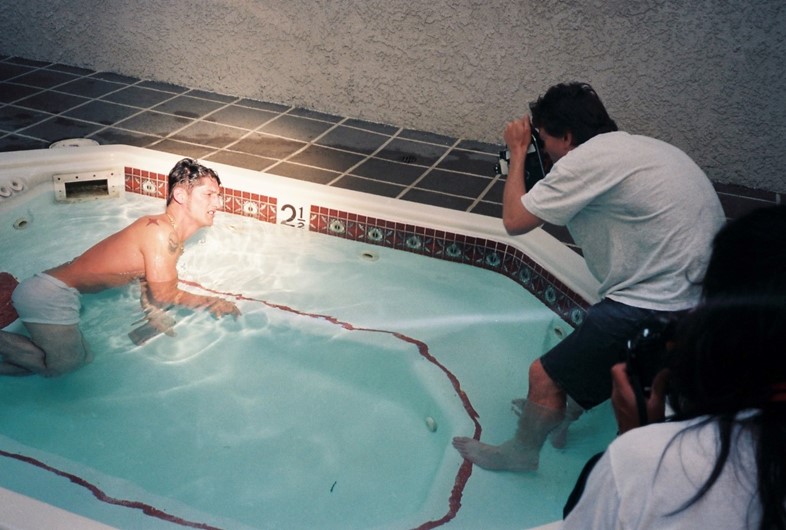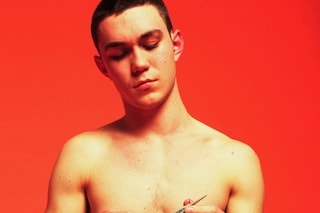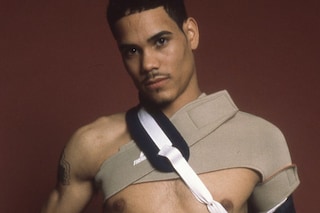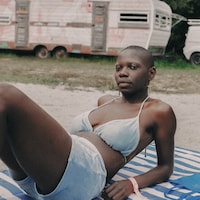A favourite of Kurt Cobain and Gus van Sant, the filmmaker has teamed up with Tom of Finland Store to give you a piece of his seminal archive
Bruce LaBruce is a cult Canadian filmmaker whose work has been dismissed, censored, and even bombed. Famously, he made it onto Kurt Cobain’s list of film favourites, and yet the director’s earlier, no-budget projects were released to mix reviews, with critics stating, half jokingly: “Someone should give Bruce LaBruce $1.98 to make another movie!”. Despite the controversy his films have provoked over the past three decades, LaBruce’s legacy is, in its own time, receiving the recognition it deserves. In 2015, the camp, blood-splattered, bizarre features that made him – in his own words – the “bastard child of New Queer Cinema” were showcased in an unprecedented retrospective at MoMA, confirming the provocateur/auteur’s place in the exclusive club of arthouse cinema. Raj Rajendra, the museum’s Chief Curator of film even likened him to an Andy Warhol of our times.
When I ask him about recognition, LaBruce says he doesn’t see pivotal moments throughout his career, but rather a “very gradual and incremental” evolution as an artist. Ever since the launch of queer punk zine J.D.s, LaBruce has embarked on various ventures besides cinema, from directing musical theatre adaptations to launching a jewellery line that includes ‘cunt’ gold rings. On the big screen, his stories take zombies, lesbian separatists and gay nazis to subversive heights, from guerilla-style to big budget films. While the variety of his work is proof of his versatility as an artist, it is imbued with a political vision that fulminates against conformist behaviours and suffocating taboos throughout. His latest feature, The Misandrists – which originated from criticisms of having never made a film about feminists – at once celebrates and parodies the politics of radical feminism.
Following exhibitions of the artist’s visual work across the world – including at London’s Gallery 46 last year – LaBruce recently launched a collaboration with the Tom of Finland Store, exhibiting 100 images from his controversial career. The filmmaker’s photographic archive covers 25 years of queercore – the movement he started – through production stills, behind-the-scenes photos, editorial for porn magazines like Honcho, Playguy, and Inches, and various candid stills of his friends and collaborators. Fans can even purchase LaBruce's limited-edition, signed prints of porn stars or add the nude portraits of unnamed hustlers, trans women and tattooed bodies to their personal collections. Here, we speak to LaBruce about the current state of LGBT representation, his early career and homemade porn.
“There always was an element of the white middle-class male gay person that was the majority of the gay movement, and they controlled the narrative of the movement in a way. Back then, my friends and I rejected that” – Bruce LaBruce
How did the collaboration with the Tom of Finland Store come about?
Bruce LaBruce: I’ve been aware of (Tom of Finland’s) work and a fan since the 80s. I used to see Tom of Finland drawings in certain gay magazines or some porn magazines, then, when I did my gay queer punk gay zine, J.D.s in the late 80s, my collaborator G.B. Jones made a series of drawings based on certain scenarios in Tom of Finland’s work – but with women instead of men. It was called Tom Girls. Those have been displayed at various art galleries around the world. So we were really into him. And then, last year, finally, I was in Los Angeles and I had a show at Lethal Amounts, a gallery downtown, and I went to the Tom of Finland foundation house. They gave me a tour, invited me for dinner, and then they screened some of my films there and that’s how I got to know them.
How and why did you start making films?
Bruce LaBruce: The short version is: I was a film student in university and I was going to be a film critique. I got a master’s degree in that. Then I started hanging out in the punk scene in Toronto and there were people working in super 8 films, so I started making short experimental super 8 films. I was always a technophobe and thought I would never make films because they’re too technically complicated and also such an expensive media so, I just started plugging away and incrementally working with slightly larger, more ambitious budgets. In the early days, I was bartending and waiting tables and partly financing my own films. But then, my first feature corresponded with the early 90s. There was this explosion of queer festivals. Suddenly, every city had its own queer festival. So films which I never intended to be screened outside punk queer spaces, suddenly were being shown internationally. I got into New Queer Cinema. I got a lot more attention with that association.
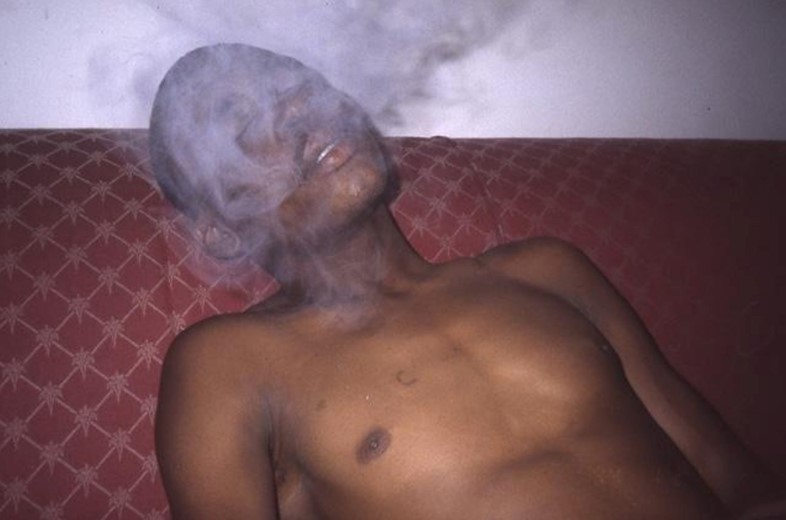
Throughout your career as a filmmaker and artist, your work has evolved around exploring “the potential of homosexual expression”, fighting conformism and more broadly, mainstream culture. How have things evolved since the 80s?
Bruce LaBruce: The whole gay movement has very much moved to assimilating into the most mainstream culture, which means buying into a lot of the more conservative institutions. Gays and lesbians used to reject marriage, monogamy, religion, but now the whole spectrum has become more conservative. There always was an element of the white middle-class male gay person that was the majority of the gay movement and they controlled the narrative of the movement in a way. Back then, my friends and I rejected that. We were punks and we didn’t like the fact that in the mainstream gay world, the sexes were segregated. Lesbians and gays didn’t really socialise together that much, trans people had no voice and were marginalised, and there were racism and classism as well – it was more about the affluent gay man. Now it even seems much more conservative in a way. On the other hand, there’s also a new generation that are rejecting identity politics and labels, so you just have to seek out these kinds of people. You reach out and find people who have a similar sensibility and a different philosophy of homosexuality that would be about non-conformity, questioning the conventions of society, sexuality – the way you’re supposed to behave.
Who embodies what you consider to be the true essence of queercore today?
Bruce LaBruce: There’s a Swedish director who is transgender, Lasse Långström, who does these queer musicals. They’re very, very interesting. I find that they really embody the new spirit of queer radicalism. Also, my friend No Bra... the way she approaches gender, it’s very forward-looking. Her gender is hard to pin down, her songs are very smart, but kind of oblique sometimes. It’s an old punk strategy to not give away everything and be more ambiguous about who you are exactly. And also being ambivalent about it yourself! To not even be sure yourself where you are. Not fixing yourself in one role or identity. It’s fluid.
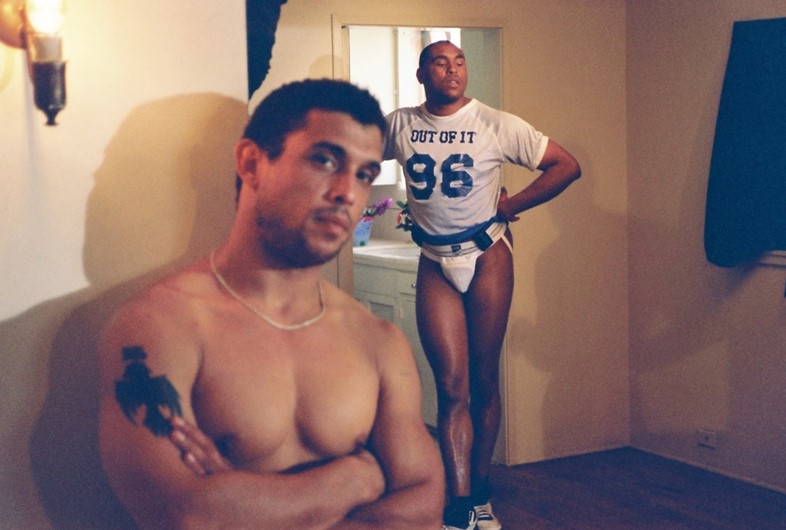
A lot of your work has explicit sex content in it and you’ve also directed porn before. How do you feel about porn being a click away these days? Has that affected the way you work?
Bruce LaBruce: I call it the ‘democratisation’ of porn. Two things happened, the advent of video, which made the process so much more accessible to anyone because it’s really easy to do. And just the platform of the internet itself. When I started making my films that had explicit content, there was no internet, so we really had to promote the old fashion way. We just sent our products to magazines and asked them to review them and promote them. It was a very slow process. Now it’s so instantaneous! In some ways, everyone can be their own little porn star if they want, which I think is good! For one thing, it produces a lot more personal porn. But there are pitfalls too: it’s still subject to exploitation and abuse. Porn, in some ways, is a very regulated industry if you’re making professional porn so there are all sorts of rules and precautions you have to take. You have to be very open with people and contracts and make sure that everybody is taken care of. So when you get into amateur porn, it can be a little more treacherous. The other thing is so many people are doing it and there’s so much porn that there’s so much bad stuff being made too. You really have to wheel through a lot of uninteresting stuff. But then occasionally you’ll find an amateur porn that is brilliant, something that has new aesthetics. Also, queer porn is huge. The films are much more experimental in form and there’s much more variety in terms of body types, gender... It’s changed the face of porn, not so much industry porn, but internet porn.
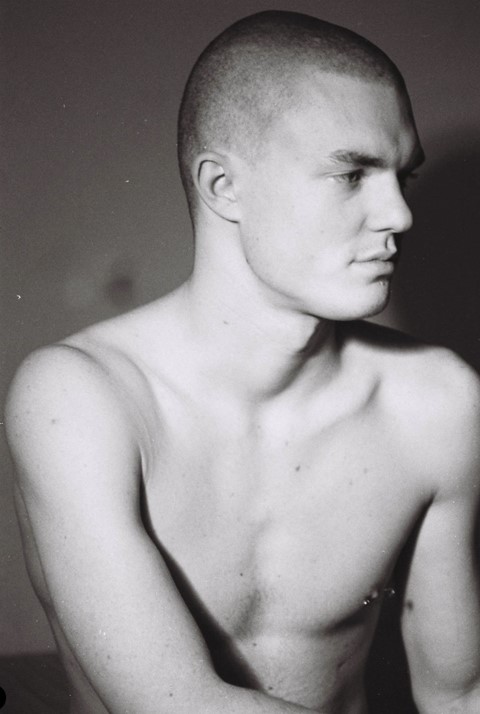
What advice would you give to young gay artists?
Bruce LaBruce: That’s tricky because everyone is on their own path. I usually give more philosophical advice. The sort of principles that I’ve adhered to: question authority and try to think of new ways of expressing yourself outside of the status quo, the regulations of society. Be adventurous. Question conventions. My philosophy of homosexuality is to not be afraid to express your sexuality and to experiment with it, even though there’s pressure to conform within the gay or queer world. All in all, to not become ideologically fixed in one spot. You have to be auto-critical and even if you’re left-identified, critique the left. It’s a good task for people because if they’re so rigid that if they can’t accept a certain amount of criticism, there is something wrong.
What are you working on at the moment?
Bruce LaBruce: The omnibus film I've done for Cockyboys, called It Is Not The Pornographer That Is Perverse..., will be out within the next couple of months, and it's going to be playing at queer and alternative film festivals. Also, the producer of my film Gerontophilia is in the process of financing a larger budgeted film I'm working on. It's called Saint-Narcisse. It's a retelling of the Narcissus myth but set in the early seventies in Quebec.
Buy a piece of Bruce LaBruce’s archive here
